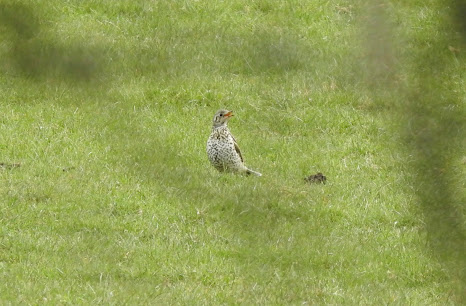I'm absolutely knackered. Perhaps because Covid robbed us of last year's spring all-dayer I was up well before the lark this morning. In fact I was in the field for 03.50. The first three birds heard were Greylag Goose, Woodpigeon (a clatter of wings), and Tawny Owl.
Owls were likely to be a problem. The resident showy Tawny Owl has not been showing lately, and I haven't seen a Little Owl since the start of the year. As for Barn Owl, well that clocked in as species number nine. I heard two birds doing their Nightjar-like purr, before one of them shrieked at me from an oak tree. Final vindication for the early start came from a couple of reeling Grasshopper Warblers.
There's always a pesky Song Thrush getting in the way.
Shortly after recording the first of three Grasshopper Warblers, Skylark joined the party as species number 12. By now it was light enough to see my notebook, and the dawn chorus was gathering pace.
I reached the flash field just as a little mist started to form, but not enough to obscure two Shelducks and an Avocet. Yes, half of the pair was back for the big day. Later on I added a record shot.
 |
| Avocet |
On completing my dawn circuit the total was on 40, and included Treecreeper and Reed Warbler, which could have proved tricky.
After breakfast I returned to find my teammates. Yes its true, I actually have a team this year. Back at Netherstead, after making short work of finding a Kestrel I rang Martin Wheeler to see where he was and what he'd seen. He was at the pool field and had found a Whinchat. I told him I wanted to make a detour down the access road for the possibility of Willow Warbler, which I duly heard, and then meet him at the Whinchat. Well I met him OK, but the Whinchat had disappeared. A flock of 30 Swallows was an unexpected sight, given how few there have been here.
We continued to the flash field where the light was much improved, and we quickly added Teal and Snipe. We also spotted three House Martins (the local colony has not returned from Africa yet), and in true bird race style I forgot to add them to the list (until now). Martin then spotted the next good species, a party of 10 Fieldfares at the top of a distant tree. A Black-headed Gull appeared (I've had trouble with them in the past, but this year they were easy peasy).
At about this time we heard from our third team member. Tony Kelly had arrived and had started birding. Poor Tony has a seriously knackered knee and was hobbling around on a stick. Despite this he had heard a Mistle Thrush, the first of three pairs of this normally difficult species we found. During the afternoon I found two adults and a juvenile near the church.
 |
| Juvenile Mistle Thrush |
We tried hard to relocate Martin's Whinchat, but were unsuccessful. Martin spotted a Bullfinch (species number 61 for the day), and we had great views of a tiny male Sparrowhawk as it shot past us to wreak havoc further down a hedge-line.
Tony decided to call it a day, while Martin and I paid a second visit to the flash. This paid off when I spotted three Sand Martins, the first here this year. We couldn't see anything else, so continued along the Morton Brook.
About fifty metres further on I found the bird of the day. Scanning the far hedge line I came to a gap, and through it, neatly framed by a triangle of branches in the hedge, stood a Ring Ouzel. "Fuck" I said. The urgency was apparent to Martin, and this was not just any old Ring Ouzel, it was a belting male facing us, chest on. I got Martin on it, but as I phoned Tony, and while Martin was putting his scope up, the bird disappeared.
At first I wasn't worried. It must have just hopped to the side, gone behind the hedge. We'd see it again. But then a flock of thrushes appeared. 35 Fieldfares (or maybe 34 and the Ring Ouzel). We lost them behind trees, and a couple of minutes later two dog-walkers appeared in the field. All became clear. So no photograph (when I could have got one if I'd been quicker).
We headed to Netherstead, congratulating ourselves on our good fortune. We were on 64 for the day. Not bad at all. Martin headed off, and I jumped in the car to return home. I made a brief stop to let Lyn know I was on my way, and at that moment a Green Woodpecker yaffled from the safety of Clowse Wood, species 65.
For the afternoon shift I was solo once more. I was also flagging. There was nothing new on the flash, and I ended up in Stapenhill Wood failing to hear any Marsh Tits. Another couple of Treecreepers was some compensation.
As I wearily made my way back across the weedy field, the sound of a corvid, a Raven I think, mobbing something had me looking in its direction. An adult Red Kite was being chased by the corvid, and I got a few record shots.
 |
| Red Kite |
Soon 66 became 67 as the final bird gave itself up. We had been fairly sure there was a Coot on the bulrush fringed top pool, but it had not been playing ball.
Missing from the list were Goldcrest, Marsh Tit, Coal tit, and Nuthatch. I could have tried harder at the death for these, but I'd had enough.
The absence of a Cuckoo was the biggest disappointment. I hope it returns soon.
I won't be getting up quite as early for the September all dayer.
No comments:
Post a Comment